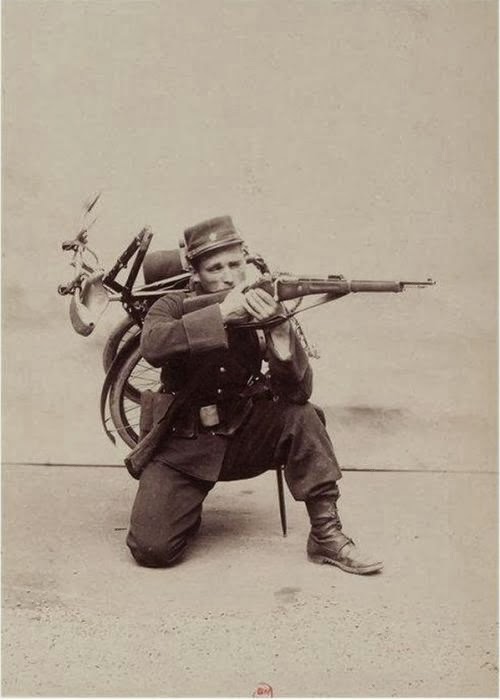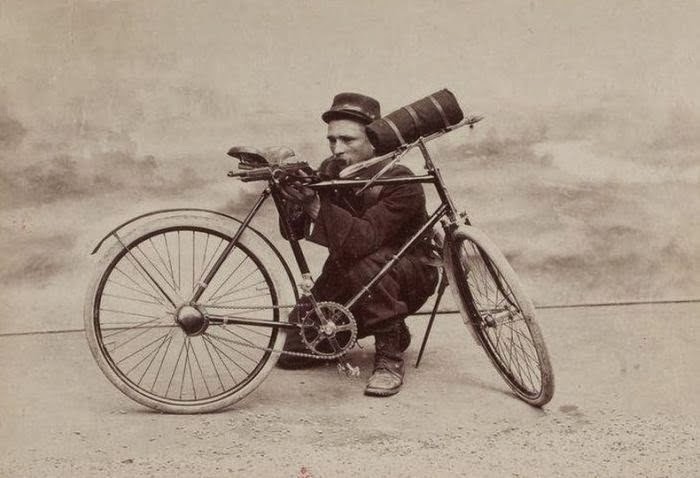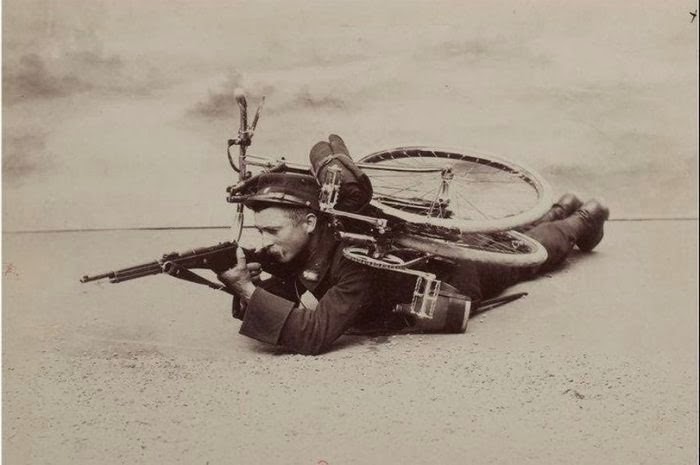
Not just any bicycle, but a folding Gladiator bicycle!


You can see the entire 13-photo set here. Thanks to Denny for pointing these pictures out!

Not just any bicycle, but a folding Gladiator bicycle!


You can see the entire 13-photo set here. Thanks to Denny for pointing these pictures out!
© 2025 Forgotten Weapons.
Site developed by Cardinal Acres Web Development.
Bicycle infantry are pretty good at covering ground without spending fuel. Folding bicycles make for better storage and handiness when dismounted… And how did the Imperial Japanese Army speed through the British lines? Bicycles, taken from the locals.
It seems that most “bike people” tend to be anti-gun, while most “gun people” tend to be anti-bike, so it’s no wonder that bicycle biathlons have never really caught on as a sport — at least not in modern times.
Perhaps this is because bicycle infantry disappeared after World War Two. With the introduction of mechanized infantry and paratroopers, nobody paid much attention to lightly armed foot soldiers on bikes. And remember that a rifleman on bicycle isn’t as fast (or heavily armed for that matter) as one on a motorcycle… Or am I wrong?
In Finland bicycle infantry was still very much a thing even in the 1990s, and I believe Jaegers still do at least some bicycle training. The Finnish Army has nearly always had a shortage of motor transports. Nowadays use of bicycles is a contingency plan, but earlier it was pretty much essential. Bicycle troops can also move along narrow footpaths in forests faster than leg infantry, and you don’t actually even need a modern cross-country bike for that (although it makes things much easier).
I think “anti-bike” is a rare thing considering almost everyone grows up with one. anti man-spats $6K race bike blocking traffic, maybe. 🙂
Hey, there must be another Denny n board… or is it not Daweo? I am guessing from Russian language.
This idea with cycling soldiers is great. One thing I wonder about and that is the visible strength of it; it looks too fragile so much more for military use. Even civilian bikes of old times (say from 20-30s) were much sturdier.
Well, one has to give the old soldiers credit for speedy deployment while saving fuel. After all, bicycle transport can be used for surprise attacks on unwary enemies in their beds. Just remember to dismount before shooting. I am not joking here. The best place for bicycle infantry is a frontier area or jungle with very few paved roads. Tanks and trucks will have trouble in the jungle, but bikes will generally do well on the narrow dirt roads.
From Wikipedia concerning Japanese biking infantry:
“In its 1937 invasion of China, Japan employed some 50,000 bicycle troops. Early in World War II their southern campaign through Malaya en route to capturing Singapore in 1941 was largely dependent on bicycle-riding soldiers. In both efforts bicycles allowed quiet and flexible transport of thousands of troops who were then able to surprise and confuse the defenders. Bicycles also made few demands on the Japanese war machine, needing neither trucks, nor ships to transport them, nor precious petroleum. Although the Japanese were under orders not to embark for Malaya with bicycles, for fear of slowing up amphibious landings, they knew from intelligence that bicycles were plentiful in Malaya and moved to systematically confiscate bicycles from civilians and retailers as soon as they landed. Using bicycles, the Japanese troops were able to move faster than the withdrawing Allied Forces, often successfully cutting off their retreat. The speed of Japanese advance, usually along plantation roads, native paths and over improvised bridges, also caught Allied Forces defending the main roads and river crossings by surprise, by attacking them from the rear. However, there were one or two cases of Australian troops turning the tables on the Japanese by isolating cycle troops from their accompanying motorized forces after blowing up bridges over rivers. Another advantage that the Japanese had with using bicycles was that it allowed an individual soldier to carry more without needing to rest and resupply often: British soldiers carried only 18 kilograms of equipment in order to march long distances through the jungles whereas Japanese bicycle soldiers could carry 36 kilograms of equipment.”
So, a walking rifleman is outdone by a biking rifleman in terms of speed and available equipment. Unless you have motorized vehicles, the only other method for carrying extra baggage is horse-cart (or ox-cart, depending on your location).
Did I mess up?
Very good and relevant comment, Cherndog — and you certainly did not mess up at all. The Wikipedia information is surprisingly accurate in this regard. One thing that was not mentioned is that bicycles were also easily shouldered and carried by soldiers fording water obstacles that were still deep enough to stop most motorized vehicles, or which had steep, slippery banks that the vehicles could not traverse, but which a foot soldier could still negotiate. Once on the other side, the bicycle would once more come into play with its relative speed, stealth and ease of usage along pathways too small for motorized transport, with all the tactical advantages this implied.
My father was a young boy in his early teens when the Japanese invaded Malaya. The family had a small farm ( a smallholding, as it was known then ) near Seremban in the state of Negri Sembilan, and they were witnesses to that portion of the Malayan Campaign in central and southern Malaya in all its violence and vivid brutality followed by nearly four years of an Occupation that was marked by constant fear and deprivation. He used to tell me all about the Japanese troops on bicycles, and how he saw them infiltrate through Allied lines via small local footpaths or tracks and directly through rubber plantations, or even sometimes straight through heavy jungle and belukar ( dense undergrowth ), repeatedly surprising the more conventional British and Australian units who did not expect anyone to be able to pass through the “impenetrable” jungle in force.
To be fair, a small number of Allied units ( primarily Australian ) adapted very quickly and effectively to this new form of bush warfare and were able to achieve significant local successes against the Japanese, especially when the latter became complacent or grew overly-confident on the propaganda being fed them by their own officers. However, the lessons learned were too little, too late and went largely ignored by Allied higher command, which continued to adhere to outdated conventional warfare principles in a country and terrain that was not suited to such to begin with.
One result, among many others, of this sort of unimaginative and inflexible thinking was that the Allies had to learn all about the entire process the hard way all over again during subsequent early-war campaigns in the Pacific, New Guinea being among the most prominent. In fact, it was mainly the Japanese under-estimation of the terrain and climate of New Guinea ( resulting in the over-reach of their supply lines and subsequent logistical breakdowns ) that saved the existing Australian forces of the time, which were unprepared and numerically inadequate, from complete annihilation during the initial stages of that campaign.
Dear Earl, it is good to ‘meet’ you again in this great place! Thank you very much for the detailed post, whose relevance is emphasized by the interesting family recollections. I can easily understand how such dramatic events became heavily imprinted in your father’s mind as a young boy. Thanks for sharing his first-hand experience with us!
Hello, Ruy —- it’s really great to hear from you too! I hope all is well with you and your family, and that life is good for all of you. I am glad that the information in my comments was of some use, and I am looking forward, as always, to reading more of your knowledgeable posts on FW. Take care and Godspeed.
We can only hope his Gladiator bicycle was sturdier and more reliable than the Gladiator (CSRG/Chauchat/”Sho-Sho”) LMG.
cheers
eon
Yeah, and one hopes that his next ride has a motor. Motorcycle cavalry seems to be a bit faster and harder to kill than organic cavalry, and for that matter ARMORED cavalry (tanks) is even more difficult to kill.
Yeah, the Gladiator in CSRG Fusil Mitrailleur was indeed that very bicycle company! And Continsouza made film equipment…
Of course the CSRG was something of the ancestor of making stamped, welded, quasi-disposable firearms like the Sten(ch) gun… Compare the ease of manufacturing with, say, the Madsen or the Lewis gun for example. Admittedly, the Madsen or Lewis would be far preferable from a user’s standpoint.
I think some problems of Chauchat were induced during usage of 8x50R Lebel, which was heavily tapered (see 2nd photo from top here: http://www.quarryhs.co.uk/Historic%20MGs.htm ), which require 180-degree magazine for as low count as 20 cartridge – such magazine shape need more power from spring, especially if magazine is dirty.
So far I know Belgian army used Chauchat in 7.65×53 Mauser (7.65 Argentine in US parlance, in terms of case shape similar to modern 7.62×51 NATO cartridge) in 1920s, however I don’t know Flemish language so I don’t know – it was reliable or unreliable?
Was Madsen or Lewis machine gun produced in 8x50R Lebel? If yes were they reliable?
I hunted from a bicycle many times as a kid. The ability to stash a bicycle out of sight is a plus that is much harder to do with 4 wheeled transport. The ability to carry more gear than you can on foot comes in handy also. I use a bicycle to get a weeks worth groceries every week. It’s a very underrated mode of transportation.
Absolutely agree! And as a definite plus, it runs on human fat as fuel… I used a bicycle on my photo hikes along densely wooden (but also in a few urban and suburban areas) with great success years ago, basically because I could spare my back of strain of carrying the heavier gear inside a backpack. I am seriously considering buying a solid and functional urban bicycle to do the same sort of daily or weekly tasks you mention.
Is there any record of parachute or glider troops landing with bicycles? Seems like the two could go well together.
“parachute”
During WW2 British manufacturer BSA produced Paratrooper’s Folding Airborne Bicycle, according to http://h2g2.com/edited_entry/A87763666 BSA bicycles were used during Operation Biting (27 February 1942) – objective was to capture some components of enemy radar equipment, this operation was success.
Photos of BSA Paratrooper’s Folding Airborne Bicycle:
https://oldbike.wordpress.com/1939-1945-ww2-bsa-airborne-folding-paratroopers-bike/
Interesting articles, thank you.
I…
Just…
Use the bike as camouflage!
xD
I cant even…
Haha!
Play dead while lying in urban rubble. The bike makes it look as if you had been hit by a transport accident…
I used to make 22 silencers from prewar french bike frames A lot of the early frames were made from seamless tubing some were even marked as aeronotic tube At one time I had over a 100 frames
I saw a lot of gladiator frames but never a folding one
“prewar french bike frames”
пистолет-пулемет Хорошмана (Хорошман sub-machine gun):
http://weaponland.ru/publ/7_62_mm_pistolet_pulemet_khoroshmana_ppkh/7-1-0-1489
was home-made partisan sub-machine gun (loosely based on PPD), some examples have barrel jackets made from bicycle frame parts.
Daweo,
The Madsen was made in 8mm Lebel for post WWI trials to replace the CSRG.
http://www.passionmilitaria.com/t50058-fm-madsen-en-8-mm-lebel
The book Honor Bound discusses how the trials went and how the FM 24 was selected.
The Madsen was also looked at by the French in the years prior to 1914 but rejected due to the cost. In regards to the Lewis Gun, I am not sure if anyone could get the Balle D to work out of the pan and action. The French Lewis guns were all in .303 British if I recall.
Actually I thought that the second picture was an example of using the bike as hard cover–which looked marginal at best.
Re the IJA and bikes–one great advantage of a bike is that you can load a lot of ammo and rice on it and effectively use it as a pushcart. So the Japanese got logistical benefits from the use of bikes as well as mobility.
And the North Vietnamese / VC used bicycles in large numbers, often with reinforced frames, to transport large amounts of supplies to the south during the ‘American’ war.
I saw a folding military motorcycle at the Johannesburg military museum last week.
Lightweight portable military motorcycles were used by almost all the major protagonists during the Second World War, including British and U.S. airborne forces. Given that you saw this particular example in a Johannesburg museum, which I believe to be the South African National Museum Of Military History, I’m guessing it might have been an Excelsior Welbike, War Department Serial No. C4659131 which had originally been developed for the SOE, but ended up being used more extensively by the British 1st and 6th Airborne Divisions during Operation Market Garden. The Welbike had folding footpegs , handlebars and seat, and after the motorcycle was removed from its special airdrop container, it reportedly took just 11 seconds to unfold everything into the ready-use position and hit the road.
Could be, I took a picture but can’t upload it.
@ Staghounds ( and to all on FW who might be interested ) :
There is a terrific website called http://www.welbike.net/Welbike Parascooter.html which has a lot of rare vintage photographs of the different versions of the Welbike in almost every conceivable operational state, from how it looks folded into its special paradrop container through various mounting configurations for the bike plus container on a transport aircraft to the bike as fully unfolded and deployed on the ground.
Staghounds, if you read this and are able to access the website described above, please confirm if the example you saw in the Johannesburg museum is actually a Welbike.
are there good modern equivalents of these? seems handy and fun
Dan, up until 2-3 years ago someone was making and marketing a paratrooper folding bicycle, presumably somewhere in China. So there might be a possibility that this idea had been floated in modern China, but as we’ve not heard much about it, rejected by the Chinese army.
It is odd that for very little in funding commitment, with the attendant physical fitness benefits, no modern army seems to have developed a martial bicycle. Perhaps it does not have the “flair” or impression of leathality that most military would like to project. However, when your very expensive motorized transport breaks down or runs out of fuel, a bicycle may look attractive to an infranty soldier wanting to move heavy loads over reasonable terrain.
Being Dutch, i’m well familiar with militairy bicycles. Since before 1900 the Dutch Army used bicycles at a rate of 20/30 to a regiment for patrolling,foraging and communication purposes. Around 1900 there was an additional 4 companies of “wielrijders” as they are called in dutch. Between 1922 and 1924 all those were reorganised first into battalions and later into a” Regiment Wielrijders”. These were strictly light, fast moving infantry with infantry arms and equipment. Early ’30s there was also a few Eskadrons ( squads ) Wielrijders, who were actually part of the reccon units of the cavalry. They dressed like cavalry with riding-pants and riding-boots while cycling.. At the time of the German invasion there were 2 Regiments, and they did cycle into action at the Grebbelinie and Grebbeberg were they performed very brave against German Wehrmacht and SS-units. Officially they existed until 1946, when all regiments and eskadrons were united in 1 Corps and discarted. I guess we might have the longest history of regular bicycle-troops in the world. 🙂 For some nice pics, google Militaire Wielrijdes, or Regiment Wielrijders.
FYI, on InRange TV (Forgotten Weapons sister site) there is a pic of a presumably Finnish bicycle of WWII vintage, with two Panzerfausts mounted along the front forks of the bicycle.